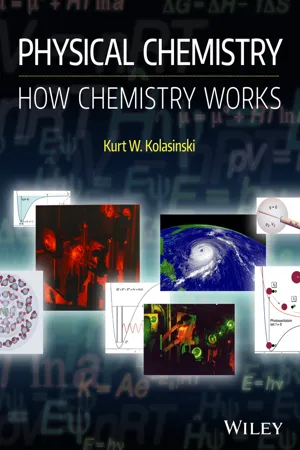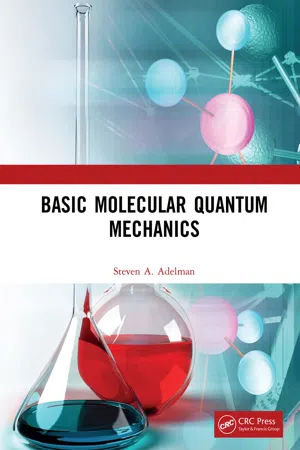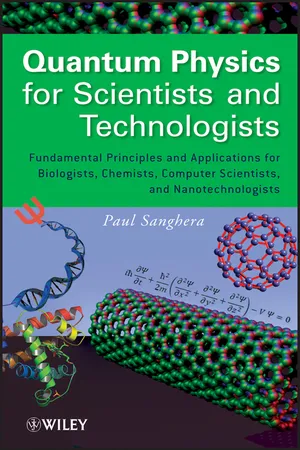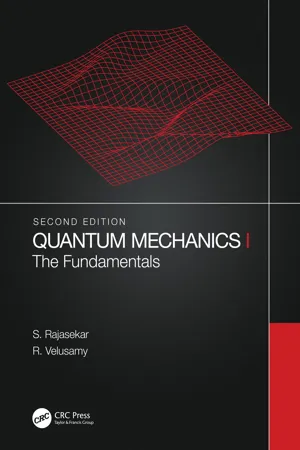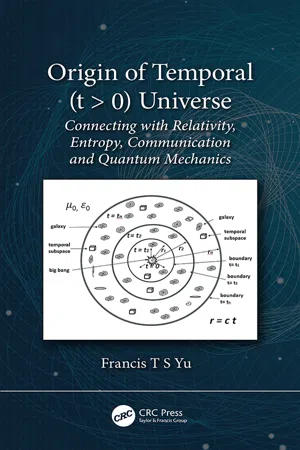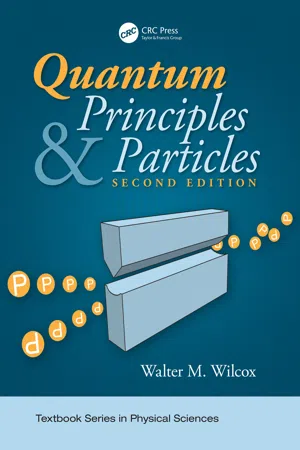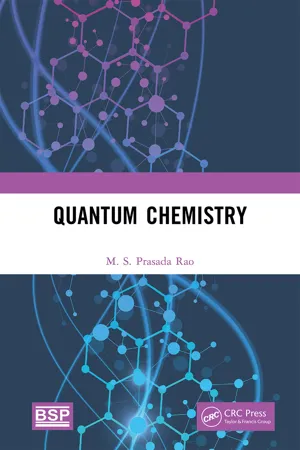Physics
Time Independent Schrodinger Equation
The Time Independent Schrödinger Equation is a fundamental equation in quantum mechanics that describes how the state of a quantum system evolves over time. It is used to find the allowed energy levels and wave functions of a quantum system. The equation is a key tool for understanding the behavior of particles at the quantum level.
Written by Perlego with AI-assistance
Related key terms
Related key terms
1 of 4
Related key terms
1 of 3
11 Key excerpts on "Time Independent Schrodinger Equation"
- eBook - ePub
- Mark Julian Everitt, Kieran Niels Bjergstrom, Stephen Neil Alexander Duffus(Authors)
- 2023(Publication Date)
- Wiley(Publisher)
We will use these results in the next section to argue for a quantum theory of measurement. Recall that the time-dependent Schrödinger equation is: We know from classical mechanics that there are many interesting systems to study where the Hamiltonian does not depend on time. Let us examine what this means for quantum mechanics. Taking a separation of variables approach, let us assume that if the Hamiltonian is time independent, solutions to the Schrödinger equation exist that can be written in the form: (3.15) where has no time dependence, and is just a complex-valued function of time. Recall, from the previous section, that we argued that, and note that Therefore, we can ensure, without loss of generality, that if lies on the unit circle. This is the case if where is some real-valued function of time. Substituting Eq. (3.15) into the Schrödinger equation yields (3.16) Now, as is just a function, and since has no time dependence, so (3.17) Pre-multiplying by, we obtain (3.18) Using and noting that is time-independent and must be some real number (as is Hermitian), which we shall call, we have (3.19) We recognise that this has the solution (3.20) Substituting back into Eq. (3.17) yields: (3.21) which we recognise as an eigenequation. For systems where the Hamiltonian is independent of time, is known of as the Time-Independent Schrödinger Equation (TISE), and the associated solutions to the Time-Dependent Schrödinger Equation (TDSE) take the form which form a complete basis. Here is termed the energy-eigenvalue and the energy-eigenvector. Note that as is Hermitian, its eigenvectors form an orthonormal basis, so any state can be written in the form Hence, the dynamics of the state are simply which is very much like a normal mode expansion in harmonic analysis - eBook - ePub
Physical Chemistry
How Chemistry Works
- Kurt W. Kolasinski(Author)
- 2016(Publication Date)
- Wiley(Publisher)
This allows us to write the time-independent Schrödinger equation, (20.19) We introduce the Hamiltonian operator (20.20) which allows us to write the time-independent Schrödinger equation in the compact form (20.21) Most of the questions we will try to answer will have their solution in the time-independent Schrödinger equation, which is why the short form in Eq. (20.21) has become so familiar. Essentially all of chemistry and physics is contained within the Schrödinger equation. This statement comes with the two very significant ‘howevers.’ The first is that we need to write down a complete Hamiltonian to describe all the interactions in our system. The kinetic energy term is easy, but the potential energy term requires detailed knowledge and a mathematical expression for every kind of interaction (electrostatic, magnetic, gravitational, chemical, van der Waals, etc.) experienced in the system. Once we can formulate all of the interactions, ‘all’ we have to do is find the wavefunctions. However – and this one is even tougher – the Schrödinger equation cannot be solved exactly for any atom or molecule containing more than one electron. Obviously, a major component of quantum mechanics is the pursuit of ever better approximations to the exact solution of the Schrödinger equation. 20.4.1 Directed practice The time-dependent Schrödinger equation is sometimes written Show that this is equivalent to Eq. (20.16). 20.5 Operators and eigenvalues Postulates III and IV intentionally mention operators and eigenvalues. To mathematicians, these are terms that are loaded with meaning invoking a Pavlovian response. They are built into the language of the postulates because they bring with them immediate clues as to how to formulate and solve the Schrödinger equation. An operator is something that carries out mathematical manipulations on the function ψ. For example, to find the momentum, apply the momentum operator to the wavefunction that describes the system - eBook - ePub
- Steven A. Adelman(Author)
- 2021(Publication Date)
- CRC Press(Publisher)
3 The Schrodinger Equation and the Particle-in-a-BoxIn Chapters 4 –6 , we lay out the full formal basis of quantum mechanics, and in the succeeding chapters, we describe increasingly advanced applications of this basis. However, in order to convey some feeling for quantum mechanics before developing its full formal machinery in this chapter, we introduce the most useful quantum equation, the time-independent Schrodinger equation, and then apply it to one of the simplest quantum systems, the instructive one-dimensional particle-in-a-box system.The time-independent Schrodinger equation, as we will show in Section 3.2 , may be derived from the more fundamental time-dependent Schrodinger equation, already touched on in Section 1.5 . So we begin with the time-dependent Schrodinger equation. This equation cannot be derived from anything more fundamental. Rather, like Newton’s equation of motion, it is best viewed as a postulate that is accepted because it successfully predicts a vast range of phenomena.While the time-dependent Schrodinger equation cannot be derived, several non-rigorous plausibility arguments for its form exist. We next give one of these.3.1 A Heuristic “Derivation” of the Time-Dependent Schrodinger Equation
In our discussion of the photoelectric effect in Section 1.1 , we noted that Einstein discovered that light exhibits a wave–particle duality, namely that a light wave of frequency υ or wavelengthλ =where c is the speed of light, could also be viewed as a stream of particles called photons each with an energy E and momentumc υ,p .Einstein postulated that the particle properties of light E and p were related to its wave properties υ and λ as follows:E = h υ a n d p =(3.1)h λ.We further noted in Section 1.4 that de Broglie later hypothesized that ordinary particles also exhibit a wave–particle duality. Namely, de Broglie hypothesized that associated with a particle is a wave with de Broglie wavelengthλ .In analogy to Einstein’s photon relationp =, de Broglie postulated that the wavelength of the matter wave associated with a particle of momentum ph λ - eBook - ePub
Quantum Mechanics
Non-Relativistic and Relativistic Theory
- Lukong Cornelius Fai(Author)
- 2022(Publication Date)
- CRC Press(Publisher)
2 Schrödinger EquationDOI: 10.1201/9781003273073-32.1 Stationary States
In the previous chapter, we did not examine the change of a state with time t . It has been assumed that we have been examining a state at a given moment t . In the general case, the state of a system changes with time t . For example, say the motion of an electron in a potential field, its wave function depends on time t :Considering the postulates of quantum mechanics, we evaluate the form of the differential equation and we use:Ψ = Ψ. Such a dependence has to be described by a differential equation in which we may haveq , t.,∂ Ψ∂ t, ⋯∂ 2Ψ∂t 2- Principle of reason. It may be formulated: The wave function of a system completely describes its properties including its properties at a given moment t as the properties during the evolution of the system with time.If we are given the initial stateΨat the initial momentq ,t 0t 0, then the stateΨof the system at the moment t should be defined univalently. The equation that we sort for should have such a structure such that from it, it should be possible to find univalently the stateq , tΨ. This follows that it should contain the derivative over time to the first order. From the principle of reason, the wave function or state function of a system evolves in time t according to the time-dependent Schrödinger equation that is the first-order differential equation with respect to time t :q , ti ℏ(2.1)=∂ Ψ∂ tΗ ^ΨwhereΗ ^is an operator acting on the wave function Ψ , and in order to find it, we should note that Equation 2.1 should be linear, considering:
- Principle of superposition: If Ψ is the solution of Equation 2.1, thenC Ψis also a solution andC = c o n s t. It follows that the linear operatorΗ ^
- eBook - ePub
Quantum Physics for Scientists and Technologists
Fundamental Principles and Applications for Biologists, Chemists, Computer Scientists, and Nanotechnologists
- Paul Sanghera(Author)
- 2011(Publication Date)
- Wiley-Interscience(Publisher)
6.3 .Solution:Equation 6.3which impliesEquations 6.5 and 6.6 are known as the time-independent Schrödinger equations in one and three spatial dimensions respectively. It is also called the steady-state Schrödinger equation because it represents a particle whose potential energy, V , does not depend on time. Therefore, the time variations of all functions of the particle have effectively the same forms as that of an unrestricted particle.As mentioned in Chapter 5, the Schrödinger equation cannot be derived from fundamental principles because the equation itself is considered to be a fundamental principle. We hold this principle to be fundamentally true. Although, like any other scientific theory or principle, it needs to be continuously tested against the experimental results and observations. Since its invention, the Schrödinger equation has withstood experimental tests. To start with, it explains all the experimental results discussed in the previous chapters that classical physics failed to explain. All the quantum laws and hypothesis discussed in these chapters proposed to explain those results are embedded in the Schrödinger equation with the right interpretation of the wave function. For example, Problem 6.9 demonstrates how you can derive the de Broglie hypothesis from the Schrödinger equation. In this and forthcoming chapters, we will continue not only to explore how this equation can be applied to the situations described in the previous chapters, but also to further explore the anatomy and physiology of atoms and molecules. - eBook - ePub
Quantum Mechanics I
The Fundamentals
- S. Rajasekar, R. Velusamy(Authors)
- 2022(Publication Date)
- CRC Press(Publisher)
As stated earlier the state of a quantum mechanical system is represented by a wave function ψ. | ψ | 2 is assumed to give the position probability density. From the solution ϕ (X) of time-independent Schrödinger Eq. (2.17), the solution of the time-dependent Schrödinger equation is written as ψ n (X, t) = ϕ n (X) e − i E n t / ℏ. (2.87) We note that | ψ n (X, t) | 2 is independent of time. Further, the time dependence of ψ n (X, t) is periodic with angular frequency ω = E n / ℏ. Such states are called stationary states. In quantum mechanics a stationary state does not mean that the system is strictly in a rest state or in a classical equilibrium point. In this state, expectation values of all dynamical variables 〈 A 〉 = ∫ − ∞ ∞ ψ n * (X, t) A ψ n (X, t) d τ = ∫ − ∞ ∞ ϕ n * (X) A ϕ n (X) d τ (2.88) are independent of time. It means that though ψ may vary with time, ψ * ψ at any point in the configuration space is independent of time. The solution ϕ n (X) of the time-independent Schrödinger Eq. (2.17) for a fixed value of E n is obviously time-independent and thus ϕ n * ϕ n is independent of time. Therefore, we call Eq. (2.17) the stationary state Schrödinger equation and its solutions as stationary state solutions or eigenfunctions. This is an energy eigenvalue equation, H ϕ = E ϕ. Consequently, when the state of the particle is the solution of Eq. (2.17) then the energy of it has a definite value given by the eigenvalue E. Suppose a particle is initially in a stationary state represented by a ψ n (X, 0) = ϕ n (X). Then from Eq. (2.87) we write ψ n (X, t) = ψ n (X, 0) e − i E n t / ℏ (2.89) and | ψ n (X, t) | 2 = | ψ n (X, 0) | 2 is independent of time. That is, if a system is initially in a stationary state then it remains in that state forever. Though ψ n (X, t) changes with time the energy and expectation values of observables remain the same. We note that the wave function given by Eq. (2.89) is a particular solution of the time-dependent Schrödinger equation - eBook - ePub
Origin of Temporal (t > 0) Universe
Connecting with Relativity, Entropy, Communication and Quantum Mechanics
- Francis T.S. Yu(Author)
- 2019(Publication Date)
- CRC Press(Publisher)
chapter sevenTemporal (t > 0) Quantum Mechanics
7.1 Schrödinger’s Timeless (t = 0) Quantum MechanicsNow, let us look back at the Schrödinger’s equation [1 ] as given by,7.1+∂ 2ψ∂x 2( E − V ) ψ = 08π 2mh 2where Ψ is the Schrödinger wave function (or Eigen function), m is the mass, E is the energy, V is potential energy, and h is the Planck’s constant. In view of this Schrödinger equation, we see that it is a dimensionless and timeless (i.e., t = 0) equation as anticipated, since his quantum machine was built by a singularity Bohr atom anchored on the top of an empty subspace. Since it is not a temporal equation, it cannot be directly implemented within our universe which is a temporal (i.e., t > 0) space [2 ,3 ]. Added Schrödinger equation does not represent the relative-position of the particle’s quantum states, since atomic particles have always been treated as a point-singularity object where the sizes and positions of the subatomic particles were neglected.Since Bohr’s atomic model is self-contained, it seems nothing to do with the subspace that the atomic model is embedded in. This is similar to one walks within a continental air craft; it seems nothing to do with our motion (or time) as with respect to the motion of our planet. However, it makes a huge difference as the atom model submerges into a timeless or a temporal subspace. If an atomic particle is submerged into a timeless subspace, their sub-atomic particles’ quantum states and locations (as had been show in the proceeding chapter) will be superimposing together and also located everywhere within a timeless subspace, as within a virtual mathematical space does. Since quantum mechanics is itself mathematics, similar to the set of Maxwell equations, the solution as obtained from the Schrödinger equation does not guarantee the existence within our temporal universe. Firstly the solution has to be a temporal (or time variable) function and secondly it has to comply with the causality condition (i.e., t >0) of the temporal universe, where its solution (i.e., wave equation) is supposed to submerging or applying in. However, when an atom model is submerged into a time-dependent or a temporal subspace, the non-coordinate subatomic particles become dimensional, since temporal subspace has coordinates. And also time is distance and distance is time within a temporal subspace [2 , 3 - eBook - ePub
- Walter Wilcox(Author)
- 2019(Publication Date)
- CRC Press(Publisher)
3Synopsis: At this point we are equipped to solve some simple but fundamental one-dimensional problems with the Schrödinger equation. After setting the stage with an introduction, four quantum mechanical problems are specified and solved. Along the way, we encounter important concepts such as parity in the case of the infinite well and harmonic oscillator problems, transmission and reflection coefficients in the case of the finite barrier, and energy bands and gaps in a model of conduction in solids. Raising and lowering ladder operators are introduced in the harmonic oscillator and square well cases. I conclude with some qualitative comments regarding expected types of solutions in one-dimensional problems.3.1 Introduction
The discussion in the last chapter centered upon the case of a free particle in a single space dimension. The Schrödinger equation can be written as
wherei ℏ∂| ψ , t 〉 = H | ψ , t 〉 ,∂ t(3.1) H =.p x 22 m(3.2) It is natural to assume that more general forms for H are possible. The form of Equation 3.2, which is an operator statement, is very classical looking. We hypothesize that the interaction of a quantum mechanical particle with an external potential V (x ) can also be represented by its classical form:H =+ V ( x ) .p x 22 m(3.3) The crucial thing that must be checked in writing down Equation 3.3 is that the probability density interpretation given to |ψ(x ,t )|2 in Equation 2.114 (Chapter 2 ), which was based on the existence of a conserved probability current, still holds. You will provide this check in a problem. By projecting Equations 3.1 and 3.3 into a coordinate ket, <x - eBook - ePub
- M. S. Prasada Rao(Author)
- 2022(Publication Date)
- CRC Press(Publisher)
Chapter 4 Applications of Schrödinger Equation-1 (Simple systems with constant potential energy)4.1 Particle in a One-dimensional Box
As an application of the postulates of quantum mechanics, we now discuss a simple problem that of a particle constrained to move in a one dimensional box. This problem is an excellent one because it illustrates a number of quantum mechanical principles, and at the same time shows how discrete energy levels inevitably arise, whenever a small particle is confined to a region in space.For the sake of simplicity, a one-dimensional box will be considered. In three-dimensional box, the wave function is represented by ψxyz and in one-dimensional box by ψx . Since the particle is to be some sort of a realistic particle, such as an electron, our wave function must be a function that does things a real particle will do. Such a function is known as a well behaved function. This requires that it is everywhere continuous, smooth, finite, and single valued.Let a particle be placed in a one-dimensional box shown below.Particle in a one-dimensional boxTo solve a problem in wave mechanics, it is necessary to solve the wave equation for the particular problem at hand.For the case of one-dimensional system, the wave equation reduces to∇ 2ψ+x y z8π 2mh 2(E − V)ψ= 0x y zFor the case of one-dimensional system, the wave equation reduces to+d 2ψ xdx 28π 2mh 2(E − V)ψ x= 0+d 2ψ xdx 28π 2mh 2(E − V)ψ x= 0It was assumed that while the particle remained in the box, it had zero potential energy. Thus, as long as the particle remains in the box, its potential energy will be zero and the wave equation will reduce further to, - eBook - ePub
- Robert Weinstock(Author)
- 2012(Publication Date)
- Dover Publications(Publisher)
Et , so that the stated assumption readswhence, because of (21 ) and (24 ),The relation (26 ) is identical with the Einstein equation (1905) relating the frequency (ω /2π ) of a light wave to the energy E of each associated light corpuscle (photon). Since the frequency, unlike the wavelength λ , associated with the motion of a particle cannot be measured directly, there is no direct experimental verification of (26 ). The validity of (26 ) is intimately connected with the validity of quantum mechanics as a whole, on purely theoretical grounds, however.11-3. The Hydrogen Atom. Physical Interpretation of the Schrödinger Wave Functions(a ) In applying the Schrödinger method to a system consisting of a fixed atomic nucleus and a single electron (of which the hydrogen atom is an example), we limit ourselves to the derivation of only those solutions which possess spherical symmetry. That is, we use spherical coordinates (r , θ , ϕ ) and seek only those wave functions ψ which are independent of the angles θ and ϕ . An analysis more complete than ours shows that the lowest energy state—the so-called ground , or normal, state , in which our interest mainly lies—possesses this symmetry, so that we do not miss consideration of it through the restrictionWe start here with the extremization problem rather than with the Schrödinger differential equation to which it leads. That is, we seek to extremize the integral (3 ) of 11-1(a )—with the appropriate potentialenergy function V inserted—with respect to functions of the form (27 ). For this purpose we employ the three identities (27 ) of 9-2(c ), with w = ψ - Kam Tim Chau(Author)
- 2019(Publication Date)
- CRC Press(Publisher)
This step of substitution, however, cannot be justified theoretically. The question is why it is appropriate to express frequency in terms of quantized energy and to express wavelength by using the de Broglie wave theory of matter. Equation (11.44) can be rewritten as(11.45)i ħ= -∂ Ψ∂ tħ 22 m+ U Ψ∂ 2Ψ∂x 2If Ψ is real, the right-hand side of (11.45) is real, but then the left-hand side is imaginary. This is impossible; thus, Ψ must be complex. Therefore, Ψ is not a measurable quantity. The physical meaning of Ψ will be discussed in Section 11.3.3 . Equation (11.45) is the 1-D Schrödinger equation, which can be rewritten into a slightly different form using the Hamiltonian operator:(11.46)where the Hamiltonian operator isi ħ=∂ Ψ∂ tH ^Ψ(11.47)H ^= -ħ 22 m+ U∂ 2∂x 2The Schrödinger equation was derived by Erwin Schrödinger in 1926 in an attempt to describe the wave behavior of a moving particle. Schrödinger received the 1933 Nobel Prize in Physics on this work. This equation cannot be obtained from known principles in physics. This is a linear second order PDE with constant coefficients (although one of them is a complex constant). The derivation of it is also not totally justifiable. It turns out that the results from solving the Schrödinger equation agree remarkable well with experiments; thus, it has been generally accepted as a physical law. This is a situation that mathematical speculation prevails in the physical world. Note also that although we call Ψ a wave function, the Schrödinger equation differs from the traditional wave equation (see for example Chapter 9 of Chau, 2018 ). To most students, the most intimidating feature of the Schrödinger equation is the appearance of the imaginary constant i
Index pages curate the most relevant extracts from our library of academic textbooks. They’ve been created using an in-house natural language model (NLM), each adding context and meaning to key research topics.
Explore more topic indexes
Explore more topic indexes
1 of 6
Explore more topic indexes
1 of 4

